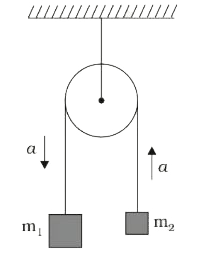Statement-1 : Two bodies of different masses and shapes may experience same thrust in a given liquid.
And
Statement-2 : The buoyancy is independent of factors of the body such as its mass and shape.
Statement-1 is True, Statement-2 is True, Statement-2 is a correct explanation for Statement-1
Statement-1 is True, Statement-2 is True, Statement-2 is not a correct explanation for Statement-1
Statement-1 is True, Statement-2 is False
Statement-1 is False, Statement-2 is True
The correct Answer is:A
To analyze the given statements, let's break down the concepts of thrust and buoyancy step by step.
Step 1: Understanding Thrust in a Fluid
Thrust in a fluid context refers to the upward force exerted on a submerged object due to the fluid. This force is known as the buoyant force.
Step 2: Buoyant Force Formula
The buoyant force (thrust) can be calculated using the formula:
Fb=ρ⋅V⋅g
where:
- Fb is the buoyant force,
- ρ is the density of the fluid,
- V is the volume of the fluid displaced (which is equal to the volume of the submerged part of the body),
- g is the acceleration due to gravity.
Step 3: Analyzing Statement 1
Statement 1 claims that two bodies of different masses and shapes may experience the same thrust in a given liquid.
- Since the buoyant force depends only on the volume of the fluid displaced (which is determined by the shape and size of the submerged part of the body), two bodies can indeed experience the same buoyant force if they displace the same volume of fluid.
- Therefore, Statement 1 is True.
Step 4: Analyzing Statement 2
Statement 2 states that buoyancy is independent of factors such as mass and shape of the body.
- The buoyant force does not depend on the mass or shape of the object but rather on the volume of fluid displaced. Thus, regardless of the mass or shape of the object, as long as the volume submerged is the same, the buoyant force will be the same.
- Therefore, Statement 2 is also True.
Step 5: Conclusion
Since both statements are true and Statement 2 correctly explains Statement 1, we conclude that the answer is:
Both statements are true, and Statement 2 explains Statement 1.
Final Answer
A: Both statements are true.
---
Thrust in a fluid context refers to the upward force exerted on a submerged object due to the fluid. This force is known as the buoyant force.
The buoyant force (thrust) can be calculated using the formula:
Fb=ρ⋅V⋅g
where:
- Fb is the buoyant force,
- ρ is the density of the fluid,
- V is the volume of the fluid displaced (which is equal to the volume of the submerged part of the body),
- g is the acceleration due to gravity.
Statement 1 claims that two bodies of different masses and shapes may experience the same thrust in a given liquid.
- Therefore, Statement 1 is True.
Statement 2 states that buoyancy is independent of factors such as mass and shape of the body.
- Therefore, Statement 2 is also True.
Since both statements are true and Statement 2 correctly explains Statement 1, we conclude that the answer is:
Both statements are true, and Statement 2 explains Statement 1.
A: Both statements are true.
Topper's Solved these Questions
- MECHANICAL PROPERTIES OF FLUIDSBook:AAKASH INSTITUTE ENGLISHChapter:MECHANICAL PROPERTIES OF FLUIDSExercise:SECTION - F
Explore 3 Videos
- MECHANICAL PROPERTIES OF FLUIDSBook:AAKASH INSTITUTE ENGLISHChapter:MECHANICAL PROPERTIES OF FLUIDSExercise:SECTION - G
Explore 6 Videos
- MECHANICAL PROPERTIES OF FLUIDSBook:AAKASH INSTITUTE ENGLISHChapter:MECHANICAL PROPERTIES OF FLUIDSExercise:SECTION - D
Explore 2 Videos
- MAGNETISM AND MATTER Book:AAKASH INSTITUTE ENGLISHChapter:MAGNETISM AND MATTER Exercise:ASSIGNMENT (SECTION D)
Explore 26 Videos
- MECHANICAL PROPERTIES OF SOLIDSBook:AAKASH INSTITUTE ENGLISHChapter:MECHANICAL PROPERTIES OF SOLIDSExercise:Assignment(Section-D)
Explore 14 Videos
Similar Questions
Two bodies of masses m1andm2(<m1) are connected to the ends of a massless cord and allowed to move as shown in figure. The pulley is both massless and frictionless. The acceleration of the centre of mass is (m1−m2)n(m1+m2)2g. Find the value of n.

View SolutionTwo bodies of different masses m1 and m2 have equal momenta. Their kinetic energies E1 and E2 are in the ratio
View Solution
Knowledge Check
Statement-1 : The centre of mass of a body may lie where there is no mass.
Statement-2 : The centre of mass has nothing to do with the mass.AIf both assertion and reason are true and reason is the correct explanation of assertion.BIf both assertion and reason are true but reason is not the correct explanation of assertionCIf assertion is true but reason is false.DIf both assertion and reason are false.
Two bodies of different masses m1 and m2 have equal momenta. Their kinetic energies E1 and E2 are in the ratio
View SolutionTwo bodies of different masses m1 and m2 have equal momenta. Their kinetic energies E1 and E2 are in the ratio
View SolutionStatement-1 : The centre of mass and centre of gravity of a body are two different positions in general.
and
Statement-2 : The centre of mass and centre of gravity of a body coincide if graviational field is unifrom.
View SolutionTwo bodies of different masses are moving with same kinetic energy. Then, the ratio of their moment is equal to the ratio of their
View SolutionTwo bodies of different masses are dropped simultaneously from same height. If air friction acting on them is directly proportional to the square of their mass, then,
View SolutionStatement-1 : Enthalpy (H) and entropy (S) both are extensive properties.
And
Statement-2 : Both are independent of mass.
View SolutionTwo bodies of masses m1andm2 have same kinetic energy. The ratio of their momentum is
View Solution